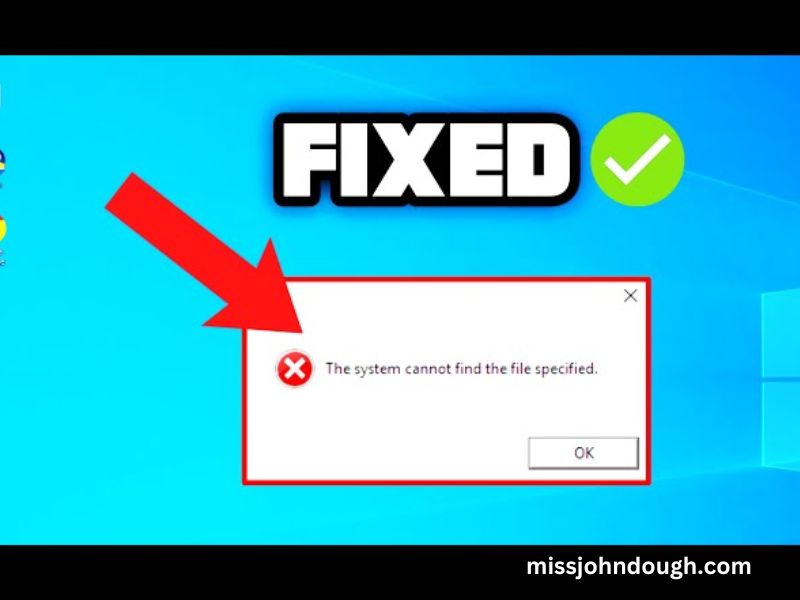When working with Ninjia or any software, encountering errors can be frustrating, especially when a common message such as “The system cannot find the file specified” appears. This error typically occurs when your system is unable to locate a necessary file or path for execution, which can halt processes and prevent users from completing their tasks. In this article, we will dive deep into the reasons behind the Ninjia “System Cannot Find the File Specified” error, how to troubleshoot it, and how to ensure smooth functioning of your software. We will cover key solutions, tips for prevention, and keyword-driven advice to enhance your Google rankings.
Understanding the Ninjia Error: “The System Cannot Find the File Specified”
The Ninjia “System Cannot Find the File Specified” error message is often a result of missing files or incorrect file paths within the Ninjia environment. Ninjia, a tool used for various tasks, typically relies on multiple components, such as external libraries or configuration files, to run smoothly. If these components are moved, deleted, or corrupted, the software will fail to find them, triggering this error message.
This issue can occur in different contexts, ranging from installation errors to file system misconfigurations. The error is especially common when the system cannot find an important file, such as a configuration file, library, or executable needed by Ninjia for proper functionality.
Common Causes of the Error
Several reasons may lead to this error, making it crucial to examine the specific circumstances in which it arises. Here are some of the most common causes for the “System Cannot Find the File Specified” error in Ninjia:
1. Missing or Corrupted Files
One of the most prevalent reasons behind this error is the absence or corruption of files. If a critical file required by Ninjia is missing, corrupted, or has been accidentally deleted, the program will not be able to function as expected. This could include .dll files, configuration files, or system libraries.
2. Incorrect File Paths
Another major cause of the error is the incorrect or changed file paths. If the file path in the configuration settings does not match the actual location of the file, the system will fail to find the file. Inaccurate file paths can be the result of updates, migrations, or changes to your file storage system.
3. Permission Issues
Insufficient permissions can also trigger this error. If Ninjia is trying to access a file located in a directory where it does not have the necessary permissions, it will not be able to retrieve or execute the file, resulting in the error message.
4. Conflicting Software
Software conflicts can lead to the Ninjia system not being able to locate the required files. If there is an incompatibility between Ninjia and other programs or applications on your system, this can cause files to be moved or hidden.
5. Corrupt Installation
Sometimes, the initial installation of Ninjia might not have completed correctly. This could be due to a variety of reasons, such as interruptions during installation or issues with the installation files themselves.
6. Outdated or Incompatible Software Versions
Using outdated versions of Ninjia or its associated libraries can also result in the error. Ninjia might be searching for files that no longer exist in the current version or are located in a different location due to updates or version changes.
How to Fix the Ninjia “System Cannot Find the File Specified” Error
Now that we’ve identified common causes of the error, it’s time to explore effective troubleshooting steps. By following these solutions, you can eliminate the error and restore the functionality of Ninjia.
1. Check for Missing or Corrupted Files
Start by verifying if any essential files have been deleted, moved, or corrupted. Reinstalling Ninjia or running the system’s file repair tools can help replace or restore any missing files.
To reinstall Ninjia:
- Uninstall the current version from your system.
- Download the latest version from the official website.
- Follow the installation prompts to ensure all files are correctly installed.
2. Verify File Paths
If you have changed the file paths or are running Ninjia on a new system, ensure that the file paths configured in Ninjia’s settings match the actual locations of the files. This includes configuration files, libraries, and executables.
To verify file paths:
- Open the configuration settings of Ninjia.
- Double-check each file path to ensure it points to the correct location.
- If necessary, use the “Browse” button to manually navigate to the file locations.
3. Run as Administrator
If permission issues are causing the error, running Ninjia as an administrator can resolve the problem. Running the program with elevated privileges allows it to access restricted files and directories.
To run Ninjia as an administrator:
- Right-click on the Ninjia shortcut.
- Select “Run as Administrator.”
- Check if the error persists.
4. Perform System File Check (SFC)
Use the built-in System File Checker (SFC) tool to scan and repair system files that may be corrupted or missing. Running SFC can restore critical files that Ninjia depends on.
To run SFC:
- Open the Command Prompt as an administrator.
- Type “sfc /scannow” and press Enter.
- Wait for the scan to complete and fix any issues found.
5. Check for Software Conflicts
Disable any unnecessary background applications that might be conflicting with Ninjia. Antivirus software, firewalls, and other system utilities can sometimes interfere with Ninjia’s ability to access files. Temporarily disable these programs and check if the error is resolved.
6. Update Ninjia and Dependencies
Ensure that you are using the latest version of Ninjia. Outdated versions may not be compatible with your system’s current configuration or operating system. Update Ninjia and its dependencies to the latest versions available.
7. Restore from Backup
If you have a backup of your Ninjia configuration or installation files, restore them from the backup. This will replace any missing or corrupted files with the original versions, which should fix the error.
Preventing the “System Cannot Find the File Specified” Error in the Future
While the solutions provided above should fix the issue, it’s essential to take steps to prevent it from recurring. By following these preventive measures, you can minimize the chances of encountering the error again.
1. Create Regular Backups
Ensure that you regularly back up your important files, including Ninjia-related files and configurations. A reliable backup will help you restore files quickly in case of corruption or accidental deletion.
2. Maintain Proper File Organization
Keep all your Ninjia-related files organized in well-defined directories. This will make it easier to identify and access files, reducing the risk of broken file paths.
3. Regularly Update Software
Regularly check for updates to Ninjia and its dependencies. New versions often come with bug fixes and improvements that can prevent errors and enhance compatibility.
4. Run Antivirus and Malware Scans
Ensure that your system is free from viruses and malware that could potentially alter or damage files. Regularly running antivirus software can prevent such issues from occurring.
5. Limit Software Conflicts
Reduce the number of programs running simultaneously on your system. Limiting background processes helps avoid potential conflicts that can interfere with Ninjia’s operation.
Conclusion
The “System Cannot Find the File Specified” error in Ninjia is an issue that can arise for several reasons, including missing files, incorrect file paths, permission issues, software conflicts, and outdated versions. By understanding the root causes of this error and implementing the troubleshooting solutions provided in this article, you can quickly resolve the issue and get Ninjia working again. Preventing the error from occurring in the future involves regular maintenance, file organization, and software updates, ensuring that your system remains in top condition for smooth operation.
By following these steps, you can enjoy a hassle-free experience while using Ninjia, minimizing downtime and maximizing efficiency.


